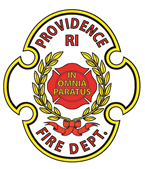Department History
The Providence Fire Department became the second professional paid organization in the country on March 1, 1854. However, much of the organizational structure, heritage, tradition and pride of the Providence Fire Department can be traced to the creation of a volunteer fire service established a hundred years earlier.
1754 brought a request by the Providence townspeople to the General Assembly to appoint James Angell and Obidiah Brown to evaluate and assess a tax in order to raise money for the purchase of the town’s first large water engine. The same act of legislation also required every Providence homeowner to acquire a pair of two gallon leather buckets to carry water to the new engine thus, forming a bucket brigade.
A second larger engine was purchased in 1759 and again the citizens of Providence petitioned the General Assembly, this time to enact a law to establish two classes of fire officials. The first were the “presidents of the fire wards”. Their primary function was to formulate policy but when a fire erupted they gave directions for tearing down or blowing up any house or houses to prevent the further spread of fire. The Presidents carried a tin speaking trumpet painted white as a symbol of their authority and used the trumpet to amplify their voices during overall command at the scene of working fires.
The second category of officers, were the “fire constables” or “fire wards.” They were empowered to direct actual firefighting efforts. Fire wards issued orders on the noisy fire ground and kept the men on the hand pumpers in time through their red trumpets. Disobeying their commands was ill advised as this would bring heavy fines.
Some time later a third category of volunteers known as engine-men were appointed to operate the engines. All volunteers were required to wear a badge on their helmet and uniform identifying which engine company they were a member. This practice is still used to identify company members.
While the speaking trumpet was in use for many years as a communication device it also has carried on to this day in another important way, as an insignia of rank. Uniform badges are one trumpet for Lieutenant, two for a Captain, and crossed gold trumpets up to five in number to signify Chief of Department.
Another company tradition that was practiced by Providence Fire Companies is the nicknaming of the apparatus or station to represent company pride. In the volunteer days, the companies that formed went by proud and colorful names such as the “Water Witch Company”, the “Pioneers”, the ” What Cheer Fire Company”, the ” Gaspee Company”, and the “Atlantic” to name a few. Today, “Roadrunners”, “Broad St. Bullies” and “Screaming Eagles” are some of the nicknames in use.
Competition and rivalries intensified among the various volunteer fire companies to the point that it began negatively impacting their conduct and efficiency on the fire ground. Their behavior did not go unnoticed. In hopes of regaining order and discipline of the fire service the City Council passed an ordinance effective March 1, 1854 creating a paid fire service directed by a Board of Engineers and a Chief Engineer who answered to the Council. When the department organized to a paid fire service there was a considerable degree of continuity in the department because most of the old engine companies maintained their identity, their station and their apparatus. The organizational structure that exists in today’s department is quite similar with ranks from Chief to Firefighter.
The change from volunteer to paid service was just one dramatic change of many for the fire service. Innovations and technological advances were constant. Suction engines were introduced eliminating the need for bucket brigades. Steam engines came next allowing for reduction in manpower but created the need for horses to pull the heavy equipment. Finally, the introduction of motor driven apparatus in 1911 has led to today’s modern firefighting apparatus.
Other notable innovations that affected fire service were improvements in the water supply system. The introduction of a telegraph street box alarm systems, and later telephones, was an important weapon in preventing fire spread by enabling quicker notification than the bell-ringing procedures. Many street boxes are still in use throughout the city over a hundred years later.
The measures taken at the formation of the Providence Fire Department to protect lives and property from being destroyed from fire and other calamities with the use of innovative tools, techniques and technology are still the trademark of our exceptional fire department.

